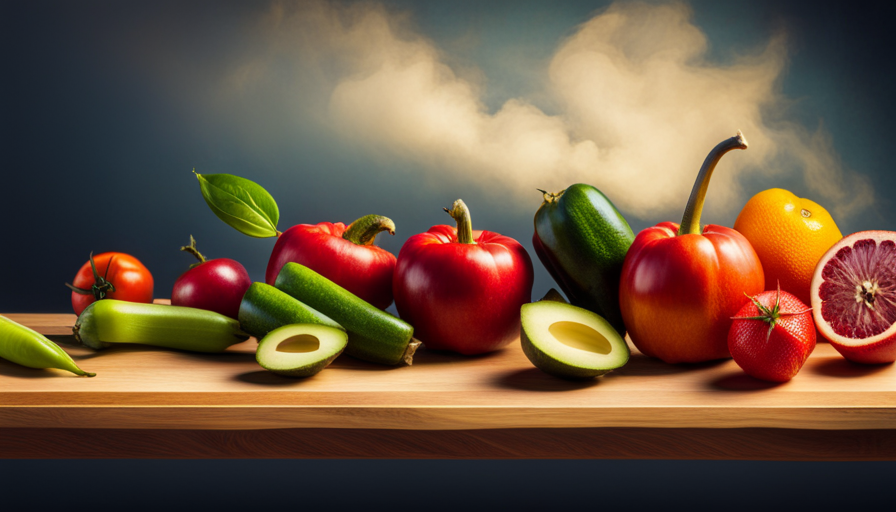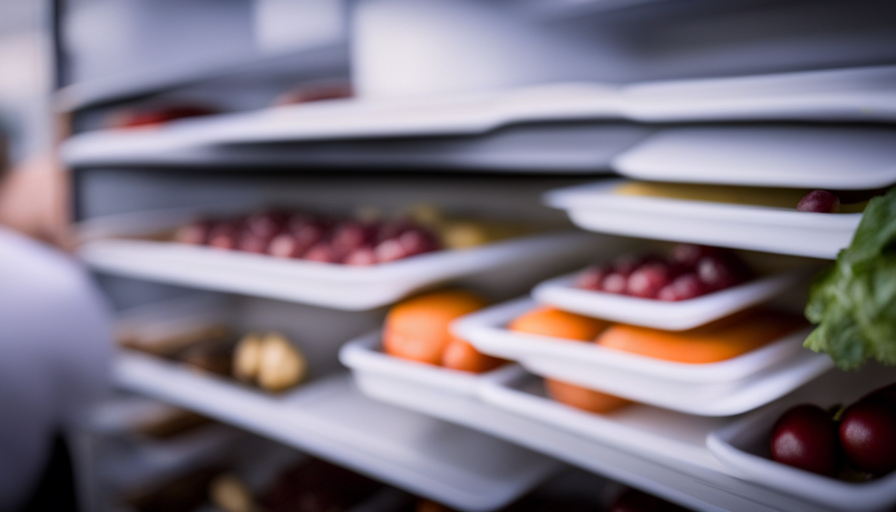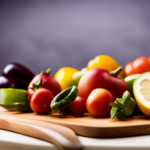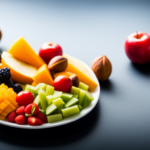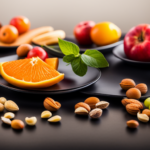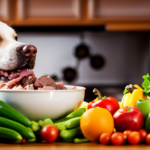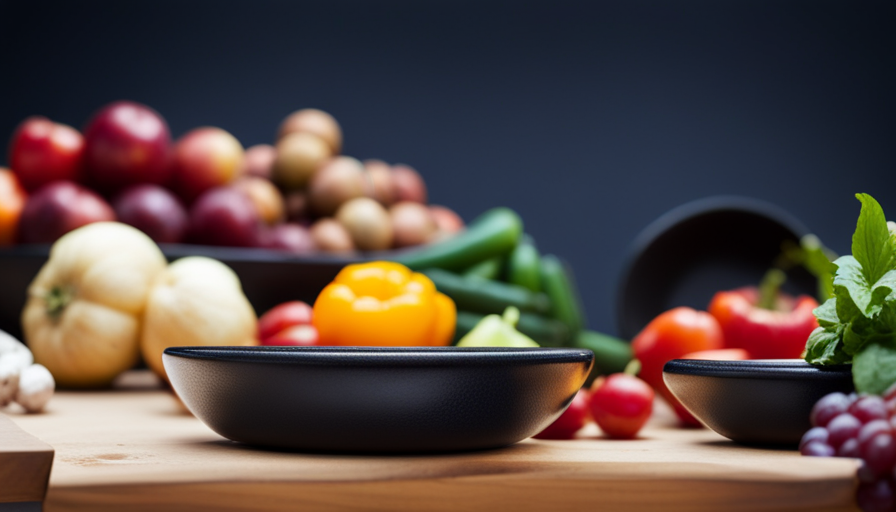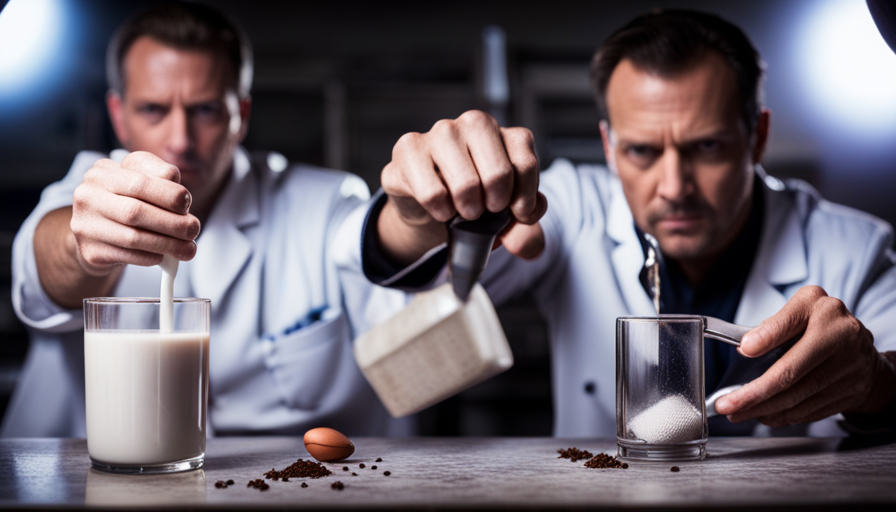Would you like to know more about the raw food diet and its specifics? You’re in the right place! This article will explore the aspects of the raw food diet, including what to incorporate into your meals and how to create delicious dishes.
Have you ever wondered how this diet can benefit your health and well-being? Or maybe you’re concerned about getting all the essential nutrients your body needs? We’ll address these questions and more, providing evidence-based information to help you make informed decisions about your dietary choices.
Additionally, we’ll debunk common myths and misconceptions surrounding the raw food diet. So, whether you’re a seasoned raw food enthusiast or just starting to dip your toes into this lifestyle, read on to discover everything you need to know about the raw food diet and what delicious foods you can enjoy!
Key Takeaways
- Raw food diet consists of uncooked and unprocessed foods like fruits, vegetables, nuts, and seeds.
- The diet is rich in vitamins, minerals, and antioxidants, and can aid in weight management and improve digestion.
- Raw fruits and vegetables are rich in dietary fiber, promoting regular bowel movements and preventing constipation.
- The diet includes a variety of fruits, vegetables, nuts, seeds, and sprouted legumes, and meal planning and preparation are crucial for success on the raw food diet.
What is the Raw Food Diet?
So, you’re considering the raw food diet? Well, imagine yourself indulging in vibrant, crisp fruits and vegetables straight from nature’s bounty, nourishing your body with pure, unadulterated goodness.
The raw food diet is a lifestyle choice where one consumes only uncooked and unprocessed foods, such as fruits, vegetables, nuts, and seeds. It’s believed that cooking food destroys essential nutrients and enzymes, so proponents of this diet argue that eating raw foods can improve overall health and vitality.
One of the main benefits of the raw food diet is that it’s rich in vitamins, minerals, and antioxidants. Fruits and vegetables in their raw form are packed with nutrients that are easily absorbed by the body. Additionally, the raw food diet is low in calories and high in fiber, which can aid in weight management and improve digestion.
Another advantage of this diet is the variety of delicious recipes available. From refreshing salads to zucchini noodles and homemade nut milks, there are endless possibilities when it comes to creating raw food dishes. These recipes not only satisfy your taste buds but also provide you with the nutrients your body needs.
Transitioning into the subsequent section about the benefits of the raw food diet, it’s important to understand how this diet can positively impact your overall well-being.
Benefits of the Raw Food Diet
To reap the rewards of the raw food lifestyle, you’ll be pleasantly surprised by the numerous advantages it brings to the table. The raw food diet is not only known for its potential to aid in weight loss, but also for its positive impact on digestion. When it comes to shedding those extra pounds, the raw food diet can be highly effective. By consuming primarily fruits, vegetables, nuts, and seeds in their raw, unprocessed state, you provide your body with nutrient-dense foods that are low in calories. This can lead to a natural reduction in weight and an increase in energy levels.
Moreover, the raw food diet is a great option for improving digestion. Raw fruits and vegetables are rich in dietary fiber, which aids in promoting regular bowel movements and preventing constipation. Additionally, the enzymes present in raw foods can help break down food more easily, allowing for better nutrient absorption and digestion.
To better understand the benefits of the raw food diet for weight loss and digestion, refer to the table below:
| Raw Food Diet Benefits |
|---|
| Weight Loss |
| Improved Digestion |
| Increased Energy |
| Nutrient-Dense Foods |
| Natural Detoxification |
Now, let’s delve into what to include in your raw food diet for optimal health and well-being, without skipping a beat.
What to Include in Your Raw Food Diet
Get ready to savor a wide array of delicious, nutrient-packed options as you embark on your raw food adventure. Incorporating raw food diet recipes into your meals can offer numerous health benefits. By consuming uncooked fruits, vegetables, nuts, and seeds, you can enjoy a diet rich in vitamins, minerals, and enzymes that are often lost during cooking.
Raw food enthusiasts claim that this way of eating can boost energy levels, improve digestion, and even support weight loss.
When it comes to what to include in your raw food diet, the possibilities are endless. Start by incorporating a variety of fresh fruits and vegetables, such as leafy greens, berries, cucumbers, and carrots. These provide essential nutrients and add vibrant colors to your plate. Don’t forget to include raw nuts and seeds, like almonds, walnuts, and chia seeds, which are excellent sources of healthy fats and protein. You can also experiment with sprouted grains and legumes to increase your fiber intake and add texture to your meals.
Transitioning into the subsequent section about how to prepare raw food meals, it’s important to note that while raw food diets are focused on uncooked foods, there are various techniques and recipes that can help you create delicious and satisfying meals without the need for cooking.
How to Prepare Raw Food Meals
Embrace the art of preparing raw food meals by exploring various techniques such as blending, juicing, and marinating, allowing you to create flavorful dishes bursting with nutrients.
When it comes to raw food meal ideas, the possibilities are endless. Here are some delicious options to consider:
- Raw vegetable salad with a tangy lemon vinaigrette dressing
- Creamy avocado soup garnished with fresh herbs
- Zucchini noodles with a rich and savory tomato sauce
- Refreshing watermelon gazpacho served chilled on a hot summer day
- Raw chocolate mousse made with avocado and cacao powder for a guilt-free dessert
The benefits of a raw food diet go beyond just taste. Raw foods retain their natural enzymes, vitamins, and minerals, which can enhance digestion, boost energy levels, and promote overall well-being. Additionally, the high fiber content in raw foods can help regulate blood sugar levels and improve gut health.
It’s important to note that while raw food meals offer numerous health benefits, it’s essential to ensure you’re still getting all the essential nutrients your body needs. Transitioning into the subsequent section about "essential nutrients to consider," it’s important to maintain a balanced raw food diet to meet your nutritional needs.
Essential Nutrients to Consider
Exploring the essential nutrients to include in your raw food meals is crucial for maintaining a well-balanced and nourishing lifestyle. Raw food diets can provide numerous nutritional benefits, but it’s important to ensure you’re getting all the necessary nutrients.
One essential nutrient to consider is protein. While many people associate protein with animal products, there are plenty of plant-based sources available for raw food enthusiasts. Foods such as sprouted legumes, nuts, and seeds are excellent sources of protein and can easily be incorporated into your meals.
In addition to protein, it’s important to ensure you’re getting enough vitamins and minerals. Leafy green vegetables, such as kale and spinach, are rich in vitamins A, C, and K, as well as minerals like iron and calcium. Fresh fruits, such as berries and citrus fruits, are packed with antioxidants and vitamin C.
To ensure a well-rounded diet, include a variety of fruits, vegetables, nuts, seeds, and sprouted legumes in your raw food meals. Experiment with different combinations and recipes to keep your meals interesting and enjoyable.
Transitioning into the subsequent section about ‘tips for success on the raw food diet,’ it’s important to remember that incorporating these essential nutrients into your meals is just the beginning. Now, let’s explore some tips for successfully maintaining a raw food diet.
Tips for Success on the Raw Food Diet
When it comes to finding success on the raw food diet, there are a few key points to keep in mind. First, meal planning and preparation is crucial. By taking the time to plan out your meals and prepare them in advance, you can ensure that you have healthy and nutritious options readily available.
Second, gradual transitioning is important when adopting a raw food diet. Instead of making drastic changes overnight, it’s best to slowly incorporate more raw foods into your diet and listen to your body’s needs.
Lastly, it’s important to listen to your body’s needs. Pay attention to how certain foods make you feel and adjust your diet accordingly. By following these tips, you can set yourself up for success on the raw food diet.
Meal Planning and Preparation
Start your meal planning by jotting down a list of delicious and nutritious recipes that’ll make your taste buds dance with joy. Meal planning is an essential part of the raw food diet, as it ensures that you have a variety of options and helps you stay on track.
Look for recipe ideas that include a mix of fruits, vegetables, nuts, and seeds to provide a balanced and nutrient-rich diet. Some popular options include green smoothies, salads with a variety of colorful vegetables, raw soups, and zucchini pasta. Experiment with different flavors and textures to keep things interesting.
Meal preparation is also key to success on the raw food diet. Take the time to wash, chop, and store your fruits and vegetables so they’re easily accessible when hunger strikes. With a little planning and preparation, you can enjoy a delicious and nutritious raw food diet.
As you become more comfortable with meal planning and preparation, you can gradually transition into the next section about ‘gradual transitioning’ to further enhance your raw food journey.
Gradual Transitioning
When it comes to transitioning to a raw food diet, it’s important to take it slow and gradually incorporate more raw foods into your meals. This gradual transitioning process allows your body to adjust and adapt to the new way of eating.
One effective strategy is to start by incorporating more raw fruits and vegetables into your meals while still enjoying some cooked foods. For example, you can have a raw salad with a side of steamed vegetables or a raw fruit smoothie with a cooked grain dish. This approach helps you maintain a balanced and varied diet while slowly increasing your raw food intake.
Listening to your body’s needs is crucial during this process, as everyone’s journey is unique. So, pay attention to how you feel after each meal and adjust accordingly. By making small changes over time, you can successfully transition to a raw food diet and reap its many benefits.
Listening to Your Body’s Needs
Listen to what your body’s telling you and make adjustments accordingly. When following a raw food diet, it’s important to pay attention to your body’s signals and practice intuitive eating. Your body knows best what it needs, so listen to its cues and respond accordingly.
If you’re feeling hungry, try incorporating more high-calorie raw foods into your meals, such as avocados, nuts, and seeds. On the other hand, if you’re feeling too full or bloated, consider reducing your portion sizes or choosing lighter, more easily digestible options like salads or smoothies.
It’s also important to stay hydrated and drink plenty of water throughout the day. By listening to your body’s needs, you can ensure that you’re providing it with the right nourishment.
Moving on to potential challenges and solutions, let’s explore how to overcome any obstacles that may arise.
Potential Challenges and Solutions
One major hurdle in following a raw food diet can be navigating social situations where your food choices may be misunderstood, but with a little creativity and a thick skin, you can find ways to stay true to your lifestyle without feeling like a fish out of water.
Here are four potential difficulties you may encounter when following a raw food diet, along with some strategies to overcome them:
-
Limited options at restaurants: Many restaurants do not offer a wide selection of raw food options. To overcome this challenge, I often research restaurants in advance and choose ones that have raw food options or are willing to accommodate my dietary needs.
-
Social pressure and criticism: People may question or criticize your food choices, making it challenging to stick to your raw food diet. To overcome this, I find it helpful to educate others about the benefits of raw food and focus on the positive changes I’ve experienced.
-
Traveling and convenience: It can be difficult to find raw food options when traveling or when you’re in a rush. To overcome this, I always pack some raw snacks, like fruits, nuts, or raw bars, to have on hand.
-
Nutrient deficiencies: Without proper planning, a raw food diet can potentially lead to nutrient deficiencies. To overcome this challenge, I ensure I’m getting a variety of fruits, vegetables, nuts, and seeds to meet my nutritional needs.
By addressing these potential challenges, you can successfully navigate a raw food diet. Moving on to common myths and misconceptions, let’s debunk some of the misconceptions surrounding raw food diets.
Common Myths and Misconceptions
Don’t be fooled by the common myths and misconceptions surrounding the world of raw food – there’s more to it than meets the eye. Let’s debunk some of the most prevalent myths and shed light on the truth about the raw food diet.
Myth #1: Raw food is tasteless and boring. Contrary to popular belief, a raw food diet can be delicious and diverse. With a wide range of fruits, vegetables, nuts, and seeds, you can create flavorful and satisfying meals. Experiment with different recipes and seasonings to find what suits your taste buds.
Myth #2: Raw food lacks essential nutrients. While it’s true that some nutrients are lost during cooking, a well-planned raw food diet can provide all the necessary nutrients for a healthy body. By incorporating a variety of plant-based foods, you can ensure you’re getting a balanced intake of vitamins, minerals, and antioxidants.
Myth #3: Raw food is unsafe and can lead to health concerns. While there are potential risks associated with consuming raw foods, such as foodborne illnesses, proper food handling and preparation can minimize these risks. It’s important to wash fruits and vegetables thoroughly and choose high-quality, organic produce.
By debunking these myths, we can see that the raw food diet offers a wide range of benefits when followed correctly. Now, let’s address some frequently asked questions about the raw food diet.
Frequently Asked Questions about the Raw Food Diet
Now that we’ve debunked some of the common myths and misconceptions surrounding the raw food diet, let’s address some frequently asked questions about this eating approach.
One of the most common questions is, "What are the health benefits of a raw food diet?" Proponents of this diet claim that it can lead to weight loss, improved digestion, increased energy levels, and a reduced risk of chronic diseases such as heart disease and diabetes. However, it’s important to note that scientific evidence supporting these claims is limited. While a raw food diet can be rich in fruits, vegetables, and whole grains, it may also be low in certain nutrients like protein, calcium, and vitamin B12. Therefore, it’s essential to carefully plan your meals to ensure you’re meeting all of your nutritional needs.
Another common question is, "How do I transition to a raw food diet?" It’s recommended to start by gradually incorporating more raw foods into your meals while still including cooked foods. This will allow your body to adjust to the increased intake of raw foods and help prevent any digestive discomfort. Over time, you can gradually increase the proportion of raw foods in your diet until you reach your desired level.
In the next section, we’ll explore some resources and further reading materials that can provide you with more information on the raw food diet and help you make informed decisions about your dietary choices.
Resources and Further Reading
Explore the vast array of literary treasures and enlightening guides that await you in the realm of resources and further reading, offering a golden key to unlock the secrets of nourishment and well-being. Whether you’re a seasoned raw food enthusiast or just embarking on this exciting journey, these resources will provide you with valuable information and inspiration to support your raw food lifestyle.
Here are three must-read resources to get you started:nn1. ‘The Raw Food Revolution’ by Cherie Soria, Brenda Davis, and Vesanto Melina: This comprehensive guide explores the benefits of a raw food diet and provides practical tips for incorporating raw foods into your daily routine. It also includes delicious recipes and meal plans to help you thrive on this nutrient-rich way of eating.
-
‘Raw Food Made Easy for 1 or 2 People’ by Jennifer Cornbleet: Perfect for beginners, this book offers simple and delicious recipes that require minimal preparation time. It also includes helpful tips on stocking your raw food pantry and navigating social situations while following a raw food diet.
-
‘The Complete Idiot’s Guide to Eating Raw’ by Mark Reinfeld and Bo Rinaldi: This easy-to-follow guide covers everything you need to know about the raw food lifestyle, from the basics of food selection and preparation to advanced techniques and recipes. It also addresses common concerns and challenges that may arise when transitioning to a raw food diet.
These resources, along with many others, will provide you with the knowledge and inspiration to thrive on a raw food diet. Happy reading and happy eating!
Frequently Asked Questions
Can I still eat cooked food on the raw food diet?
Yes, you can still eat cooked food on the raw food diet, but it’s important to limit it. The focus of a raw food diet is on consuming uncooked, unprocessed foods that are rich in nutrients and enzymes. However, incorporating some cooked food alternatives can provide variety and help with the transition. Cooking can alter the nutrient content of food, but steaming or lightly sautéing vegetables can still retain some of their beneficial properties. Remember, balance is key in any diet.
Is it safe for children and pregnant women to follow the raw food diet?
As the saying goes, ‘you are what you eat.’ When it comes to the raw food diet for toddlers, it’s important to ensure their nutritional needs are met. While raw fruits and vegetables can provide beneficial vitamins and minerals, it’s crucial to consult a healthcare professional for guidance to avoid any nutrient deficiencies.
As for pregnant women, a raw food diet can offer benefits such as increased intake of fiber and antioxidants. However, it’s crucial to ensure proper nutrition and consult a healthcare provider for personalized advice.
Can I still get enough protein on a raw food diet?
Yes, you can still get enough protein on a raw food diet. There are plenty of raw food diet protein sources available, such as nuts, seeds, and legumes. Incorporating these foods into your meals can help ensure you meet your protein needs.
Some raw food diet meal ideas include a salad with mixed greens, avocado, and hemp seeds, or a smoothie made with almond milk, spinach, and chia seeds. Remember to vary your protein sources to get a wide range of nutrients.
Are there any specific foods I should avoid on the raw food diet?
There are a few foods to avoid on a raw food diet to minimize potential health risks.
One of the biggest culprits is raw meat, as it can harbor harmful bacteria.
Additionally, it’s best to steer clear of unpasteurized dairy products, as they can contain harmful pathogens.
Another food to avoid is raw eggs, which may contain salmonella.
Lastly, raw sprouts can also pose a risk, as they have been linked to outbreaks of foodborne illnesses.
It’s important to prioritize food safety when following a raw food diet.
Can I eat out or go to restaurants while on the raw food diet?
Yes, you can still eat out or go to restaurants while on the raw food diet. However, it can be a bit challenging to find fully raw food options at most restaurants. It’s always a good idea to call ahead and ask if they have any raw food options available. Eating raw food at home has its benefits, such as increased nutrient intake and improved digestion. But occasionally dining out can also be a fun and enjoyable experience.
What Are the Best Foods to Eat on a Raw Food Diet?
When starting a raw food diet, it’s best to focus on fruits, vegetables, nuts, seeds, and sprouted grains. These high-fiber, nutrient-dense foods provide essential vitamins, minerals, and enzymes. Incorporating a variety of colorful produce and incorporating raw sauces and dressings can make the transition easier and more enjoyable.
Conclusion
In conclusion, the Raw Food Diet is like a vibrant garden blooming with health benefits. By incorporating a variety of fresh fruits, vegetables, nuts, and seeds into our meals, we can nourish our bodies with essential nutrients.
However, it’s important to be mindful of potential challenges and ensure we’re getting all the necessary nutrients. By following the right resources and preparing our meals with care, we can reap the rewards of this natural and nutrient-rich way of eating.
So let’s dive into the colorful world of raw food and cultivate a healthier lifestyle!

